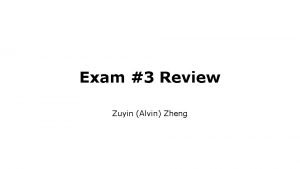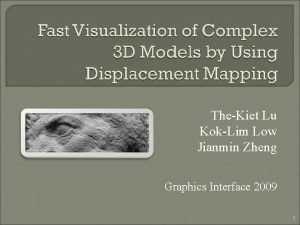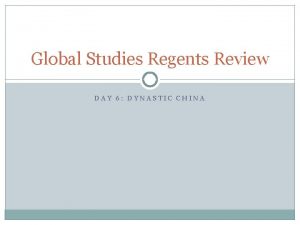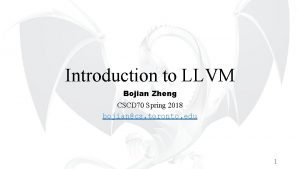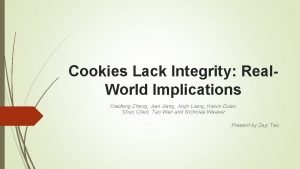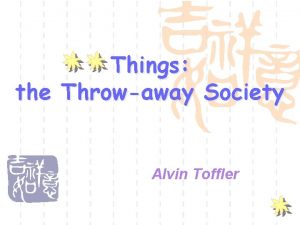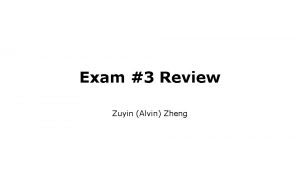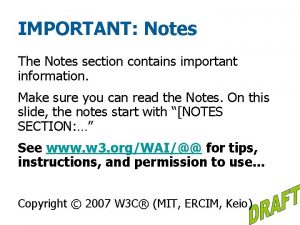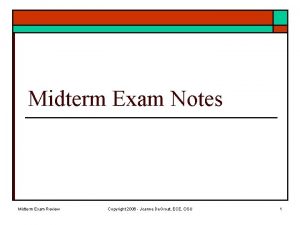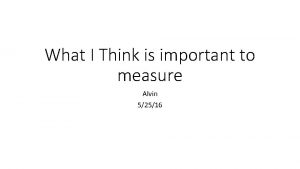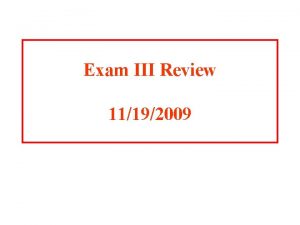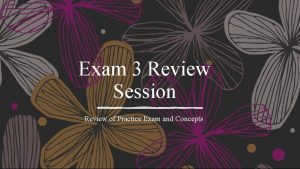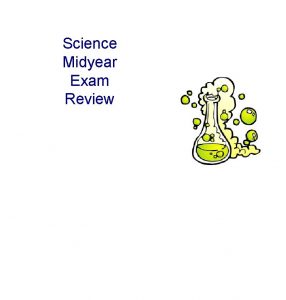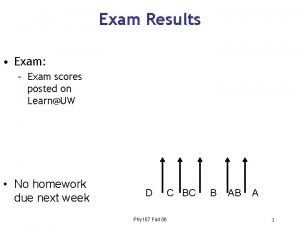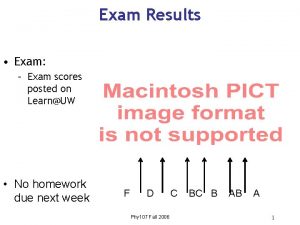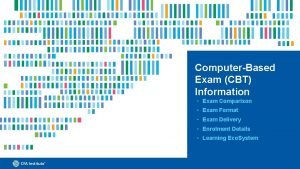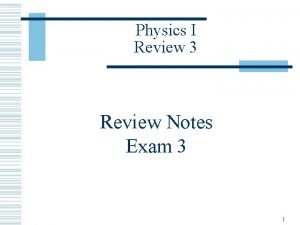Exam 3 Review Zuyin Alvin Zheng Important Notes





























- Slides: 29

Exam #3 Review Zuyin (Alvin) Zheng

Important Notes o Time 2 hours NOT 50 minutes ü Monday, May 8, 8: 00 am – 10: 00 am o Location ü Regular Class Room Alter Hall 231 o Calculator ü Do please bring your own calculator ü You will NOT be allowed to share calculators during the exam

Overview of the Exam (Time Matters) o Part 1: Multiple Choice (50 Points) ü 25 questions * 2. 5 points each o Part 2: Interpreting Decision Tree Output (16 Points) ü 6 questions, short answers are required o Part 3: Interpreting Clustering Output (14 Points) ü 5 questions, short answers are required o Part 4: Computing Support, Confidence, and Lift (20 Points) ü 4 questions, calculations and short answers are needed o Bonus Questions: ü 2 questions * 2 points each

Using R and R-Studio

R and R-Studio o Open source, free o Many, many statistical add-on “packages” that perform data analysis o R Packages contain additional functionality (The base/engine) o Integrated Development Environment for R o Nicer interface that makes R easier to use o Requires R to run (The pretty face)

R Syntax 1 o Define variables ü R is case sensitive ü Variable names can start with a letter or digits ü The assignment operator in R is <- or = o Functions ü c(), rep(), and sort() are functions ü Each function consists of function name and ()

R Syntax 2 o Define and Index Vectors ü We use combine function to define a vector c() ü We use brackets [ ] to index elements in a vector o Access a variable from a dataset ü We use $ to index a variable (column) from a data set (a table) Load Data into R Access a Variable

Understanding Descriptive Statistics

Summary Statistics o summary ü Provides basic summary statistics o describe ü Provides detailed summary statistics o describe. By ü Provide summary statistics by groups

Read and Interpret a Histogram o For a histogram ü What does x axis represent? ü What does y axis represent? o Basic statistics ü Mean ü Median • 1, 3, 3, 6, 7, 8, 9 • 1, 2, 3, 4, 5, 6, 7, 8 ü What does it mean if the mean is greater (or smaller) than the median?

Hypotheses Testing: t-test and P-value o T-test ü Compares the mean between two groups/ samples o P-value ü <0. 05, means the difference between the means is statistically significant ü >=0. 05, means the difference between the means is statistically insignificant

Decision Tree Analysis

What is Classification? o A statistical method used to determine to what category (or “class”) a new observation belongs ü Pay off the loan / Purchase organic food/ Legitimate Charge o How to classify? ü Decision Tree ü Training Set ü Validation Set o How to evaluate decision tree? ü Correct classification rate ü Error rate + Correct classification rate =1

Read the Decision Tree o How many leaf nodes? /What’s the size of the tree? o What does 0. 85 mean? o How likely a person with a 50 k income and 10% debt is going 1 -Default 0 -No Default to default? o Who are most likely to default? o Who are least likely to default? Answer: Customers whose income is less than 40 k, debt is smaller than 20% and house is owned are the least likely to default. 1 0. 85 Owns house 0 0. 20 Rents 0 0. 30 Owns house 0 0. 22 Rents 1 0. 60 0 0. 26 Debt >20% Income <40 k Debt <20% Credit Approval Debt >20% Income >40 k Debt <20%

How to calculate the classification accuracy? o A Confusion Matrix compares the predicted outcomes to the observed (actual) outcomes The Confusion Matrix Predicted outcome: Observed outcome: Default No default Default 600 100 No default 150 650 Total: 1500 o Correct classification rate=(600+650)/1500=0. 83 o Error rate=1 -0. 83=0. 17

Control Tree Size o Tree size and classification accuracy ü A bigger tree =using more predictor=more leaf nodes = a larger size ü Larger tree leads to higher classification accuracy but makes the tree more complex ü Goal: a simple tree with high classification accuracy (high correct classification rate) Minimum split • Minimum number of observations in each node needed to add an additional split. • Smaller minimum split → More complex tree Complexity factor • Minimum reduction in error needed to add an additional split. • Smaller complexity factor → More complex tree

Clustering Analysis

What is Cluster Analysis? o Grouping data so that elements in a group will be ü Similar (or related) to one another ü Different (or unrelated) from elements in other groups ü We don’t know how many groups we have beforehand o How to cluster: K-means ü Grouping data based on distances ü Red dots are centroid (centers)

How to Evaluate Clusters? o Within-cluster SSE 1 1. 3 SSE 1 = 12 + 1. 32 + 22 = 1 + 1. 69 + 4 = 6. 69 2 Within-cluster SSE: o Between-cluster SSE SMALL –High Cohesion Between-cluster SSE: LARGE –High Separation We want High Cohesion and High Separation Cluster 1 We want Small Within-SSE and Large Between-SSE Cluster 5 More Clusters Higher Cohesion (Good) More Clusters Lower Separation (Bad)

Interpreting Clustering Results 1 o Summary Statistics for Each Cluster 1) > aggregate(k. Data, by=list(My. KMeans$cluster), FUN=mean) Group. 1 Region. Density. Percentile Median. Household. Income Average. Household. Size 1 1 0. 8835353 -0. 2681572 -0. 5992532 2 2 -1. 1224866 -0. 5594931 -0. 5055258 3 3 -0. 4836836 -0. 1400215 0. 3502257 4 4 0. 9557776 -0. 3145690 1. 3672892 5 5 0. 8561222 1. 3520755 0. 2790425 ü What’s the characteristics of cluster 1 compared to the population? ü What does a positive / negative value mean?

Interpreting Clustering Results 2 o Within-Cluster SSE > # Display withinss (i. e. the within-cluster SSE for each cluster) > print("Within cluster SSE for each cluster (Cohesion): ") [1] "Within cluster SSE for each cluster (Cohesion): " > My. KMeans$withinss [1] 6523. 491 4990. 183 6772. 426 2707. 390 5102. 896 ü What’s the Within-Cluster SSE for Cluster 4? ü Which cluster has the highest cohesion? ü Which cluster has the lowest cohesion? ü What is the range of the Within-Cluster SSE ?

Interpreting Clustering Results 3 o Between-Cluster SSE > # Display betweenss (i. e. the between-cluster SSE between clusters) > print("Total between-cluster SSE (Seperation): ") [1] "Total between-cluster SSE (Seperation): " > My. KMeans$betweenss [1] 45301. 67 > # Compute average separation: more clusters = less separation > print("Average between-cluster SSE: "); [1] "Average between-cluster SSE: " > My. KMeans$betweenss/NUM_CLUSTER [1] 9060. 334 ü What’s the average Between-Cluster SSE? ü What’s the total Between-Cluster SSE?

Association Rules Mining

What is Association Rule Mining? o Find out which items (X) predict the occurrence of other items (Y) ü Basket Analyses o Itemset: A collection of items of interest o Support count ( ) ü In how many baskets does the itemset appear? ü {Milk, Diapers, Beer} = 2 ü {Milk, Diapers} = 3 Basket Items 1 Bread, Milk 2 Bread, Diapers, Beer, Eggs 3 Milk, Diapers, Beer, Coke 4 Bread, Milk, Diapers, Beer 5 Bread, Milk, Diapers, Coke

Support and Confidence o Support (s) Basket Items ü Support count ( ) / total number of baskets 1 Bread, Milk ü Measures whether the itemset appears often 2 Bread, Diapers, Beer, Eggs ü s{Milk, Diapers}= 3/5 = 0. 6 3 Milk, Diapers, Beer, Coke ü s{Bread}= 4/5 = 0. 8 4 Bread, Milk, Diapers, Beer 5 Bread, Milk, Diapers, Coke • Bread appears very often in shopping baskets ü Is s(X, Y) always greater/smaller/equal to s(X)? o Confidence (c) is the strength of the association between two itemsets ü c(X Y): use X to predict Y, X is the attendant and Y is the consequent ü c(X Y) is always between 0 and 1 ü

Lift o What’s the problem with confidence? ü The purpose of association rule mining is to predict Y with X ü If X and Y are frequently purchased items, the confidence will be large but X is a bad predictor of Y ü So we need to account for the natural occurrence of both X and Y o Lift ü Measures whether two itemsets X and Y appear together at the same frequency as random chance ü Lift > 1 The occurrence of X , Y together is more likely than what you would expect by chance [Good] Lift<1 The occurrence of X , Y together is less likely than what you would expect by chance [Bad] Lift=1 The occurrence of X , Y together is the same as what you would expect by chance

Example 1 o What’s the lift for the rule: {Milk, Diapers} {Beer} ü X = {Milk, Diapers} ; Y = {Beer} ü s(X, Y)= 2/5 = 0. 4 s(X) = 3/5 = 0. 6 s(Y) = 3/5 = 0. 6 ü c(X Y)=0. 4/0. 6=0. 67 Basket Items 1 Bread, Milk 2 Bread, Diapers, Beer, Eggs 3 Milk, Diapers, Beer, Coke 4 Bread, Milk, Diapers, Beer 5 Bread, Milk, Diapers, Coke ü The support is 0. 4, meaning that {Milk, Diapers, Beer} appears very often ü The confidence is 0. 67, indicating there is a strong association between {Milk Diaper} and {Beer} ü The Lift is greater than 1, suggesting that {Milk, Diapers} and {Beer} occur together more often than a random chance, thus is predictive.

Example 2 Netflix Cable TV No Yes s (Netflix, Cable TV) s (Cable TV ) s (Netflix ) No 200 8000 Yes 3800 1000 What is the effect of Netflix on Cable TV? {Netflix Cable TV) = 1000/13000 7% = 9000/13000 69% = 4800/13000 37% Having one service negatively affects the purchase of the other (lift closer to 0 than 1)

Good Luck!
 Alvin zuyin zheng
Alvin zuyin zheng Writ of certiorari ap gov example
Writ of certiorari ap gov example Zheng he biography
Zheng he biography Jianmin zheng
Jianmin zheng Dr xisui shirley chen
Dr xisui shirley chen The map shows that on his voyages, zheng he explored *
The map shows that on his voyages, zheng he explored * Should we celebrate the voyages of zheng he dbq answer key
Should we celebrate the voyages of zheng he dbq answer key The arts
The arts Cscd70
Cscd70 Zheng
Zheng Task 1 unit 4
Task 1 unit 4 Shuran zheng
Shuran zheng Cindy zheng
Cindy zheng Whyjay zheng
Whyjay zheng Patrick zheng
Patrick zheng Zheng jiang history
Zheng jiang history From most important to least important in writing
From most important to least important in writing Inverted pyramid in news writing
Inverted pyramid in news writing Least important to most important
Least important to most important Dr kerolos morkos
Dr kerolos morkos Alvin high school jacketeers
Alvin high school jacketeers The throw-away society by alvin toffler summary
The throw-away society by alvin toffler summary Porridge king alvin koh
Porridge king alvin koh Jade stenger alvin isd
Jade stenger alvin isd Alvin isd gifted and talented
Alvin isd gifted and talented Skyward alvinisd
Skyward alvinisd Obstculos
Obstculos Alvin isd grading scale
Alvin isd grading scale Alvin isd grading scale
Alvin isd grading scale Alvin isd registration
Alvin isd registration
